
Things were looking up for Earth about 12,800 years ago. The last Ice Age was coming to an end, mammoths and other large mammals romped around North America, and humans were beginning to settle down and cultivate wild plants. Then, suddenly, the planet plunged into a deep freeze, returning to near-glacial temperatures for more than a millennium before getting warm again. The mammoths disappeared at about the same time, as did a major Native American culture that thrived on hunting them. A persistent band of researchers has blamed this apparent disaster on the impact of a comet or asteroid, but a new study concludes that the real explanation for the chill, at least, may lie strictly with Earth-bound events.
The study “pulls the rug out from under the contrived impact hypothesis quite nicely,” says Christian Koeberl, a geochemist at the University of Vienna. Most evidence for the extraterrestrial impact hypothesis, he says, was conjured up “out of thin air.”
The 1300-year big chill is known as the Younger Dryas, so called because of the sudden worldwide appearance of the cold-weather flowering plant Dryas octopetala. A number of causes have been suggested, including changes in ocean currents due to melting glaciers and volcanic activity. In 2007, a diverse group of 26 researchers, led by nuclear chemist Richard Firestone of the Lawrence Berkeley National Laboratory in California, formally proposed what is known as the Younger Dryas impact hypothesis, in which one or more extraterrestrial bodies blew up over North America, leading to widespread wildfires and strewing sun-blocking dust and debris across the globe.
In a series of papers, Firestone and his colleagues claimed various kinds of evidence for the hypothesis, including deposits of the element iridium (rare on Earth but abundant in meteorites), microscopic diamonds (called nanodiamonds), and magnetic particles in deposits at sites supposedly dated to about 12,800 years ago. The notion was popularized in television documentaries and other coverage on the National Geographic Channel, History Channel, and the PBS program NOVA. These claims were sharply contested by some specialists in the relevant fields, however, who either did not detect such evidence or argued that the deposits had other causes than a cosmic impact. For example, some say that nanodiamonds are common in ordinary geological formations, and that magnetic particles could come from ordinary fires.
Now comes what some researchers consider the strongest attack yet on the Younger Dryas impact hypothesis. In a paper published online this week in the Proceedings of the National Academy of Sciences, a team led by David Meltzer, an archaeologist at Southern Methodist University, Dallas, in Texas, looks at the dating of 29 different sites in the Americas, Europe, and the Middle East in which impact advocates have reported evidence for a cosmic collision. They include sites in which sophisticated stone projectiles called Clovis points, used by some of the earliest Americans to hunt mammals beginning about 13,000 years ago, have been found, such as Chobot in Alberta, Canada, Murray Springs in Arizona, and Paw Paw Cove in Maryland; the site of Abu Hureyra in Syria, where evidence of plant-cultivating hunter-gatherers occurs; and sites in Greenland, Germany, Belgium, and the Netherlands where other evidence for an impact has been claimed. The team argues that when the quality and accuracy of the dating—which was based on radiocarbon and other techniques—is examined closely, only three of the 29 sites actually fall within the time frame of the Younger Dryas onset, about 12,800 years ago; the rest were probably either earlier or later by hundreds (and in one case, thousands) of years.
“The supposed Younger Dryas impact fails on both theoretical and empirical grounds,” says Meltzer, who adds that the popular appeal of the hypothesis is probably due to the way that it provides “simple explanations for complex problems.” Thus, “giant chunks of space debris clobbering the planet and wiping out life on Earth has undeniably broad appeal,” Meltzer says, whereas “no one in Hollywood makes movies” about more nuanced explanations, such as Clovis points disappearing because early Americans turned to other forms of stone tool technology as the large mammals they were hunting went extinct as a result of the changing climate or hunting pressure.
Maarten Blaauw, a paleoecologist at Queen’s University Belfast in the United Kingdom, finds the new work convincing. “It is vital to get the ages right,” he says, which “appears to have been lacking in the case of the [impact] papers” that Meltzer and his colleagues reanalyzed. “This paper should be read widely, and its lessons learned by the paleo community and by archaeologists.”
But impact proponents appear unmoved by the new study. “We still stand fully behind the [impact hypothesis], which is based on more than a confluence of dates,” Firestone says. “Radiocarbon dating is a perilous process,” he contends, adding that the presence of Clovis artifacts and mammoth bones just under the claimed iridium, nanodiamond, and magnetic sphere deposits is a more reliable indicator that an extraterrestrial event was responsible for their disappearance.
Note : The above story is based on materials provided by Michael Balter forAmerican Association for the Advancement of Science.










